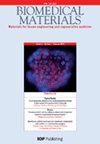3D printed hydroxyapatite promotes congruent bone ingrowth in rat load bearing defects
IF 3.7
3区 医学
Q2 ENGINEERING, BIOMEDICAL
引用次数: 4
Abstract
3D porous hydroxyapatite (HAP) scaffolds produced by conventional foaming processes have limited control over the scaffold’s pore size, geometry, and pore interconnectivity. In addition, random internal pore architecture often results in limited clinical success. Imitating the intricate 3D architecture and the functional dynamics of skeletal deformations is a difficult task, highlighting the necessity for a custom-made, on-demand tissue replacement, for which 3D printing is a potential solution. To combat these problems, here we report the ability of 3D printed HAP scaffolds for in vivo bone regeneration in a rat tibial defect model. Rapid prototyping using the direct-write technique to fabricate 25 mm2 HAP scaffolds were employed for precise control over geometry (both external and internal) and scaffold chemistry. Bone ingrowth was determined using histomorphometry and a novel micro-computed tomography (micro-CT) image analysis. Substantial bone ingrowth was observed in implants that filled the defect site. Further validating this quantitatively by micro-CT, the Bone mineral density (BMD) of the implant at the defect site was 1024 mgHA ccm−1, which was approximately 61.5% more than the BMD found with the sham control at the defect site. In addition, no evident immunoinflammatory response was observed in the hematoxylin and eosin micrographs. Interestingly, the present study showed a positive correlation with the outcomes obtained in our previous in vitro study. Overall, the results suggest that 3D printed HAP scaffolds developed in this study offer a suitable matrix for rendering patient-specific and defect-specific bone formation and warrant further testing for clinical application.3D打印羟基磷灰石促进大鼠负重缺陷骨向内生长
传统发泡工艺制备的3D多孔羟基磷灰石(HAP)支架对支架的孔径、几何形状和孔间连通性的控制有限。此外,随机的内部孔隙结构往往导致有限的临床成功。模仿复杂的3D结构和骨骼变形的功能动力学是一项艰巨的任务,突出了定制的,按需组织替换的必要性,3D打印是一个潜在的解决方案。为了解决这些问题,我们报告了3D打印HAP支架在大鼠胫骨缺损模型中的体内骨再生能力。使用直接写入技术制造25 mm2 HAP支架的快速原型设计用于精确控制几何形状(外部和内部)和支架化学。骨长入是通过组织形态学和一种新型的微型计算机断层扫描(micro-CT)图像分析来确定的。在填充缺损部位的种植体中观察到大量骨长入。显微ct进一步定量验证了这一点,缺损部位种植体的骨矿物质密度(BMD)为1024 mgHA ccm−1,比缺损部位假对照的BMD高约61.5%。苏木精和伊红显微图未见明显的免疫炎症反应。有趣的是,本研究与我们之前的体外研究结果呈正相关。总之,结果表明,本研究中开发的3D打印HAP支架为呈现患者特异性和缺陷特异性骨形成提供了合适的基质,值得进一步测试临床应用。
本文章由计算机程序翻译,如有差异,请以英文原文为准。
求助全文
约1分钟内获得全文
求助全文
来源期刊

Biomedical materials
工程技术-材料科学:生物材料
CiteScore
6.70
自引率
7.50%
发文量
294
审稿时长
3 months
期刊介绍:
The goal of the journal is to publish original research findings and critical reviews that contribute to our knowledge about the composition, properties, and performance of materials for all applications relevant to human healthcare.
Typical areas of interest include (but are not limited to):
-Synthesis/characterization of biomedical materials-
Nature-inspired synthesis/biomineralization of biomedical materials-
In vitro/in vivo performance of biomedical materials-
Biofabrication technologies/applications: 3D bioprinting, bioink development, bioassembly & biopatterning-
Microfluidic systems (including disease models): fabrication, testing & translational applications-
Tissue engineering/regenerative medicine-
Interaction of molecules/cells with materials-
Effects of biomaterials on stem cell behaviour-
Growth factors/genes/cells incorporated into biomedical materials-
Biophysical cues/biocompatibility pathways in biomedical materials performance-
Clinical applications of biomedical materials for cell therapies in disease (cancer etc)-
Nanomedicine, nanotoxicology and nanopathology-
Pharmacokinetic considerations in drug delivery systems-
Risks of contrast media in imaging systems-
Biosafety aspects of gene delivery agents-
Preclinical and clinical performance of implantable biomedical materials-
Translational and regulatory matters
 求助内容:
求助内容: 应助结果提醒方式:
应助结果提醒方式:


